How to seal a gas meter: legal details of sealing
Few people will find it difficult to purchase a metering device.The main thing is that it meets state standards and has the appropriate documentation, but not everyone knows how to seal a gas meter.
Meanwhile, the absence of a seal or its incorrect installation is a guarantee of payment for gas according to standards, and not based on consumption. The procedure will take a little of your time, but you must admit, it’s better to take the trouble and do everything right away according to the rules than to pay many times more later and have to redo everything anyway.
We will tell you how to seal the meter correctly, where to go for this, what legal standards to follow, and whether it is worth damaging the “seal” for the sake of dubious savings on twisting readings.
The content of the article:
Why seal the meter?
To prevent the consumer from interfering with the operation of the IPU by stopping or slowing down the meter for unaccounted energy consumption, the device is subject to mandatory sealing.
The access indicator is not so easy to bypass and is still the most reliable protection against unauthorized user influence.
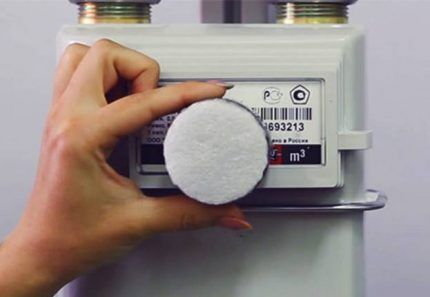
Installation of an indicator or re-sealing occurs in the following cases:
- during the initial commissioning of the IPU;
- failure of the old indicator, its intentional damage, failure of the magnetic indicator, accident;
- replacing the old meter;
- dismantling of the seal for some reason by an employee of the resource supply organization.
In any case, this procedure is necessary and mandatory for everyone who does not want to pay according to the standards.
Legislative acts on installation of seals
Obligations to install meters for energy consumption are determined Federal Law N 261 (11/23/2009 as amended on 07/26/2019) in article 13, paragraph 1. At the same time, the requirements of the article do not apply to dilapidated, emergency-type facilities, where gas consumption is less than 2 cubic meters per hour, apartment buildings with wear of 70% and not included in the capital construction program, as well as those subject to demolition and reconstruction.
According to Article 9 of the Federal Law of June 26, 2008 N 102-FZ “On ensuring the uniformity of measurements”, meters must be equipped with limiters that prevent unnoticed interference in their operation, leading to distortion of readings.
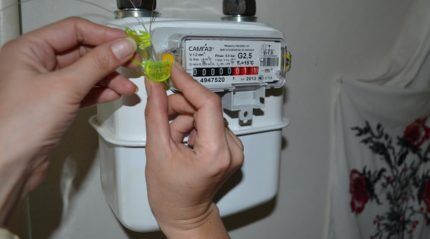
For gas appliances this is as many as 2 seals, as indicated in PP No. 549 - factory indicator and installed by the supplier at the point where the IPU is connected to the gas pipeline. Only if both are intact and from the day of installation of the second one, the meter readings are taken into account.
How and where to apply?
Installation of a gas meter an organization with appropriate accreditation has the right to perform. However, only the resource supplier can put seals, and therefore put the device into operation.
This can be done on different days, but it should be taken into account that only after the conclusion of an agreement on resource accounting will the countdown of the IPU readings begin.
You can submit an application for sealing during a personal visit to the resource supply organization, but if you do not want/cannot come to the company’s office, you can simply call there. The specialist who responded to your request must leave your address, contact phone number, specify the date of installation of the metering device, and also agree on the date/time of connection at the site.
In addition, you can be called within 3 days on the phone number you left to agree on a different date if work organizations are busy or have an urgent call to another site. However, the new date must be no later than 15 days after receipt of the application.
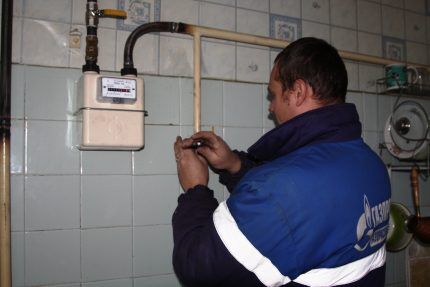
If the specialist does not appear at the agreed time, or new deadlines are proposed more than 15 days after the application, the metering device can be considered put into operation from the moment a written application for sealing is submitted, according to Government Decree No. 354.
That is why personal attendance at the office is most preferable. You will have in your hands a document confirming the application, when the specialists call you, they will issue it at the site (unless otherwise provided by the rules of the organization). However, the application procedure is possible only after installation of the device.
Let's consider what documents and subscriber data are needed to seal a gas meter and put it into operation:
- Personal information of the future user - full name, passport data, phone number.If the applicant is a legal entity, then you will also need to indicate the name of the organization and its place of registration, as well as the company’s telephone number.
- Proposed and agreed date for commissioning of the device.
- The type of IPU, as well as its serial number and the place in which it is installed (or it is intended to be installed while simultaneously being sealed).
- If the meter is installed, then information about the organization that carried out the installation.
- Readings on the meter when installing it.
- Verification date according to the intercheck interval from the last factory mark.
You must have a photocopy of the IPU passport with you and, if the device is not new, the latest verification report.
The procedure for sealing the meter
So, a specialist from a gas supply organization has come to you to carry out the procedure for putting the meter into operation.
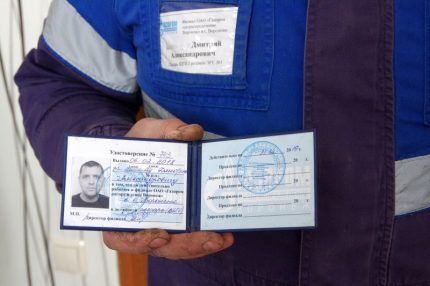
First of all, he checks the documentation for the metering device, the absence of distortions and correct installation, operability and the possibility of a low-burning functionality mode. If something is wrong, he writes you a refusal indicating the reasons; if everything is fine, he installs seals and numbered control and security stickers, the information from which is entered into the acceptance certificate.
A specialist can also install an anti-magnetic seal; the law does not prohibit such actions. The anti-magnetic tape has a capsule, which, when interacting with a magnet (a popular method of braking a meter), is broken and immediately indicates an attempt at unauthorized intervention.
The legality of installing antimagnetic indicators is specified in clause 81(11) Government Decrees No. 354.
After completing all procedures, an act is drawn up in 2 copies, one remains with the organization, the second with the consumer. The act must be carefully studied before signing. Among other information, it contains information about the location of installation of security seals and the date of the next verification.
At whose expense is the filling installed?
The “stamp” on the IPU is installed in the interests of the supplier, that is, the resource supplying organization. On the other hand, companies are not required to put seals on consumer meters, and their presence is legally required.
Initially, when putting the device into operation, the organization installs them free of charge to its subscribers, but subsequent sealings are paid by the client according to a separately concluded agreement. This point is also noted in Government Decree No. 549, paragraph 22 "b".
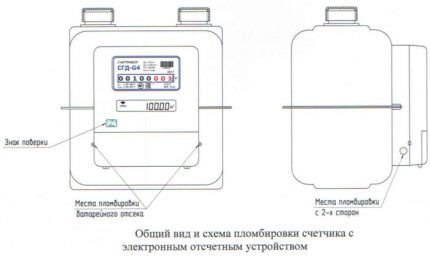
The cost of sealing after repair, reinstallation or gas meter replacement is set by the supplier, and there are no uniform prices. It may vary depending on the consumables used, the controller’s transportation costs and other nuances, but usually does not exceed 300-400 rubles.
How to remove or bypass a filling?
There is a lot of bad advice on the Internet from experts in bypassing the IPU “seals”. We do not recommend doing this for several reasons.
This procedure is not as simple as it seems at first glance; it is very easy to damage the filling. And even if you succeed, the resource supplying organization can easily pay attention to underestimated consumption figures and carry out an unscheduled inspection.And traces of intrusion into the operation of the meter will be almost 100% visible.
According to the aforementioned RF PP No. 549, if the seal is damaged, the subscriber pays compensation, the amount of which varies depending on how it was discovered.
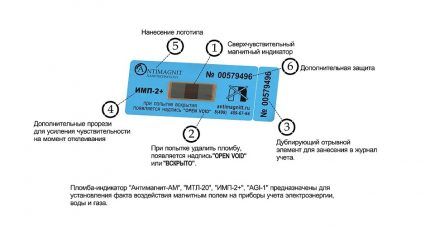
Thus, paragraph 25 states that if the consumer notified the supplier about this on the day the defect was discovered, payment will be made according to general standards from the day the damage was reported until the day following the installation of a new seal.
If the damage was discovered by gas company employees during a standard inspection, compensation will be calculated according to the same standards, but from the date of the last inspection until a new seal is installed. Since inspections are carried out every six months, in accordance with PP No. 549, it is more profitable to immediately contact the service organization and inform them that you have problems with the integrity of the indicator.
In addition, you may be fined for damaging the “seal”, according to Code of Administrative Offenses of the Russian Federation Article 19.2. The amount, however, is small - from 100 to 300 rubles. But if deliberate destruction of the indicator is proven, the fine can be much higher.
What to do with the seal when replacing the meter?
If you are going to change the meter or when sending it to the laboratory for verification, do not rush to dismantle the device, even if all deadlines have already expired.
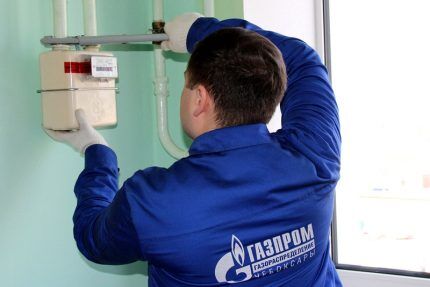
Replacement if its functionality is impaired or simply choosing another model carried out by specialists from the organization with which the subscriber has an agreement. In this case, it is necessary to take the latest readings and check the integrity of all seals. For this procedure, you will also need to draw up an application and sign an inspection report.
The re-sealing procedure is carried out similarly to the primary one. In this case, do not forget to take a receipt for payment for the sealing.
Conclusions and useful video on the topic
Here's why you shouldn't try to fool metering devices:
The procedure for sealing a heat meter is very important for every consumer. It is one of the main parts of putting the device into operation and the starting point when paying for resources according to its indicators. As you can see, it is not at all difficult as it seems and not so expensive.
Share in the comments with our readers how your gas meter was sealed and what difficulties you encountered. And also, ask questions - we will try to answer even the most complex of them in detail.




We have a situation like this. In December last year, the seal on our gas meter came off, this was approximately from December 3 to December 5. On December 7, I went to the gas workers, and in the city we have 3 gas offices. She reported that the seal had crumbled due to age and the wire had fallen off. and that we need to change the gas meter from the first of January. 8 years have passed since its installation. I was told to wait for our employee. He came on December 28th. My mother-in-law was 85 years old and was at home. she let him in. He did not leave any document. We bought a new meter and installed it only after the New Year holidays on January 13th. On January 15, I left Kislovodsk for Chelyabinsk to visit my elderly mother to take care of her.then coronavirus, I had to stay with her until mid-June. Last year we overpaid 17 thousand for gas, I go to pay for gas taking into account the deduction of this amount from the readings of the new meter, and they tell me that I have a fine of 57 thousand for breaking the seal? Is this legal? After all, even if some kind of act was drawn up, then my signature should be there? and where is the fine of 300 rubles?
The most impudent office. Doesn't provide any certificates of work performed, they are rude, the employees are incompetent. Got it, wrote to the prosecutor's office. I am waiting